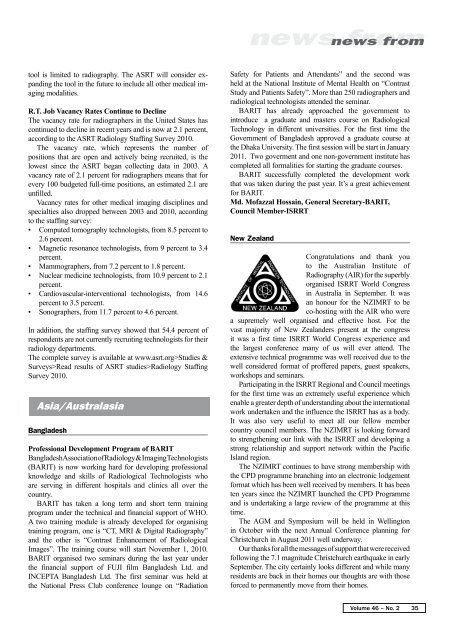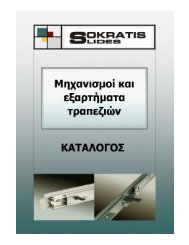isrrt Newsletter Volume 6. No.2 - 2010
You also want an ePaper? Increase the reach of your titles
YUMPU automatically turns print PDFs into web optimized ePapers that Google loves.
news news from<br />
tool is limited to radiography. The ASRT will consider expanding<br />
the tool in the future to include all other medical imaging<br />
modalities.<br />
R.T. Job Vacancy Rates Continue to Decline<br />
The vacancy rate for radiographers in the United States has<br />
continued to decline in recent years and is now at 2.1 percent,<br />
according to the ASRT Radiology Staffing Survey <strong>2010</strong>.<br />
The vacancy rate, which represents the number of<br />
positions that are open and actively being recruited, is the<br />
lowest since the ASRT began collecting data in 2003. A<br />
vacancy rate of 2.1 percent for radiographers means that for<br />
every 100 budgeted full-time positions, an estimated 2.1 are<br />
unfilled.<br />
Vacancy rates for other medical imaging disciplines and<br />
specialties also dropped between 2003 and <strong>2010</strong>, according<br />
to the staffing survey:<br />
• Computed tomography technologists, from 8.5 percent to<br />
2.6 percent.<br />
• Magnetic resonance technologists, from 9 percent to 3.4<br />
percent.<br />
• Mammographers, from 7.2 percent to 1.8 percent.<br />
• Nuclear medicine technologists, from 10.9 percent to 2.1<br />
percent.<br />
• Cardiovascular-interventional technologists, from 14.6<br />
percent to 3.5 percent.<br />
• Sonographers, from 11.7 percent to 4.6 percent.<br />
In addition, the staffing survey showed that 54.4 percent of<br />
respondents are not currently recruiting technologists for their<br />
radiology departments.<br />
The complete survey is available at www.asrt.org>Studies &<br />
Surveys>Read results of ASRT studies>Radiology Staffing<br />
Survey <strong>2010</strong>.<br />
Asia/Australasia<br />
Bangladesh<br />
Professional Development Program of BARIT<br />
Bangladesh Association of Radiology & Imaging Technologists<br />
(BARIT) is now working hard for developing professional<br />
knowledge and skills of Radiological Technologists who<br />
are serving in different hospitals and clinics all over the<br />
country.<br />
BARIT has taken a long term and short term training<br />
program under the technical and financial support of WHO.<br />
A two training module is already developed for organising<br />
training program, one is “CT, MRI & Digital Radiography”<br />
and the other is “Contrast Enhancement of Radiological<br />
Images”. The training course will start November 1, <strong>2010</strong>.<br />
BARIT organised two seminars during the last year under<br />
the financial support of FUJI film Bangladesh Ltd. and<br />
INCEPTA Bangladesh Ltd. The first seminar was held at<br />
the National Press Club conference lounge on “Radiation<br />
Safety for Patients and Attendants” and the second was<br />
held at the National Institute of Mental Health on “Contrast<br />
Study and Patients Safety”. More than 250 radiographers and<br />
radiological technologists attended the seminar.<br />
BARIT has already approached the government to<br />
introduce a graduate and masters course on Radiological<br />
Technology in different universities. For the first time the<br />
Government of Bangladesh approved a graduate course at<br />
the Dhaka University. The first session will be start in January<br />
2011. Two goverment and one non-government institute has<br />
completed all formalities for starting the graduate courses.<br />
BARIT successfully completed the development work<br />
that was taken during the past year. It’s a great achievement<br />
for BARIT.<br />
Md. Mofazzal Hossain, General Secretary-BARIT,<br />
Council Member-ISRRT<br />
New Zealand<br />
Congratulations and thank you<br />
to the Australian Institute of<br />
Radiography (AIR) for the superbly<br />
organised ISRRT World Congress<br />
in Australia in September. It was<br />
an honour for the NZIMRT to be<br />
co-hosting with the AIR who were<br />
a supremely well organised and effective host. For the<br />
vast majority of New Zealanders present at the congress<br />
it was a first time ISRRT World Congress experience and<br />
the largest conference many of us will ever attend. The<br />
extensive technical programme was well received due to the<br />
well considered format of proffered papers, guest speakers,<br />
workshops and seminars.<br />
Participating in the ISRRT Regional and Council meetings<br />
for the first time was an extremely useful experience which<br />
enable a greater depth of understanding about the international<br />
work undertaken and the influence the ISRRT has as a body.<br />
It was also very useful to meet all our fellow member<br />
country council members. The NZIMRT is looking forward<br />
to strengthening our link with the ISRRT and developing a<br />
strong relationship and support network within the Pacific<br />
Island region.<br />
The NZIMRT continues to have strong membership with<br />
the CPD programme branching into an electronic lodgement<br />
format which has been well received by members. It has been<br />
ten years since the NZIMRT launched the CPD Programme<br />
and is undertaking a large review of the programme at this<br />
time.<br />
The AGM and Symposium will be held in Wellington<br />
in October with the next Annual Conference planning for<br />
Christchurch in August 2011 well underway.<br />
Our thanks for all the messages of support that were received<br />
following the 7.1 magnitude Christchurch earthquake in early<br />
September. The city certainly looks different and while many<br />
residents are back in their homes our thoughts are with those<br />
forced to permanently move from their homes.<br />
<strong>Volume</strong> 46 – No. 2 35

















